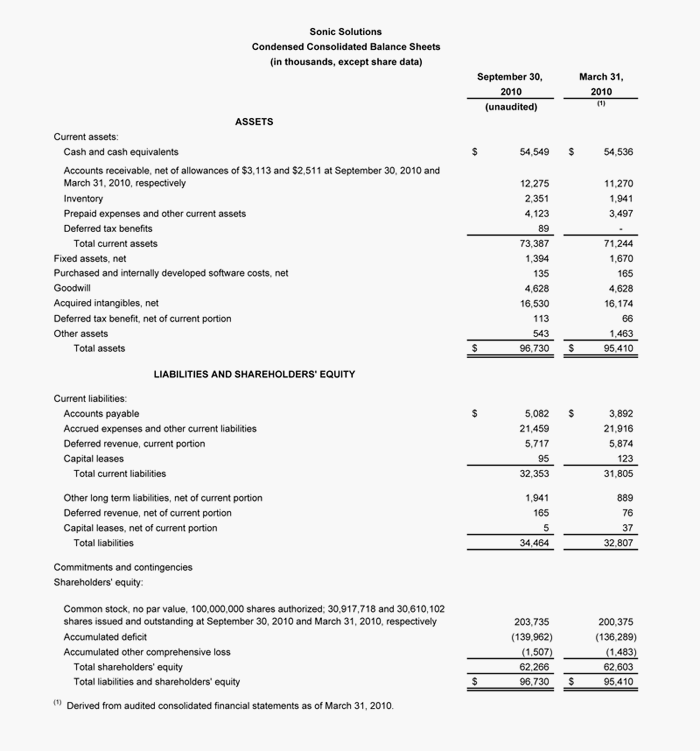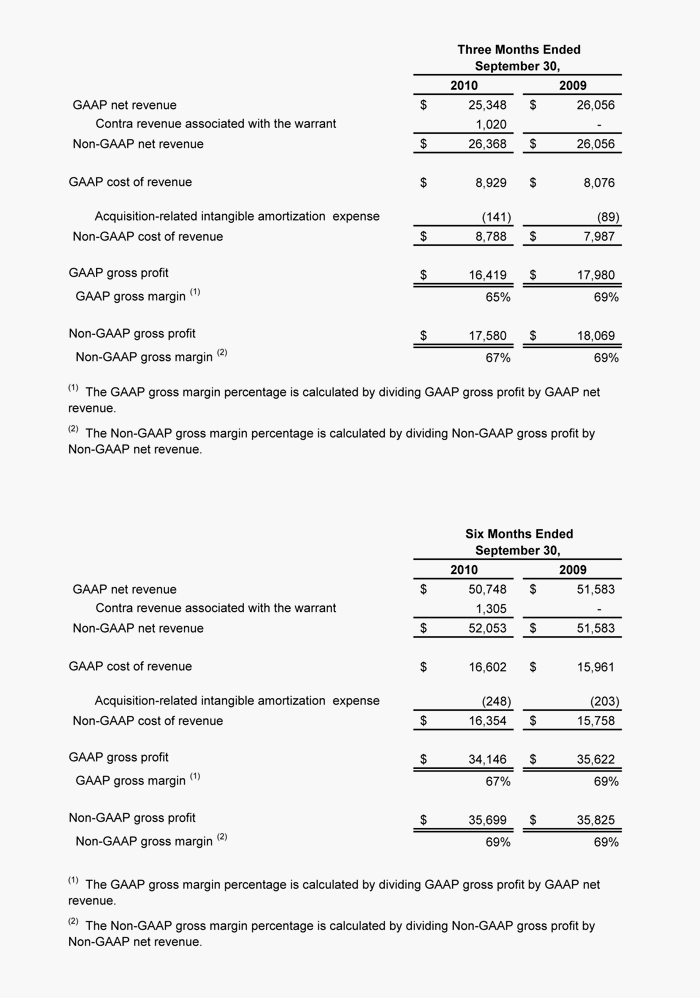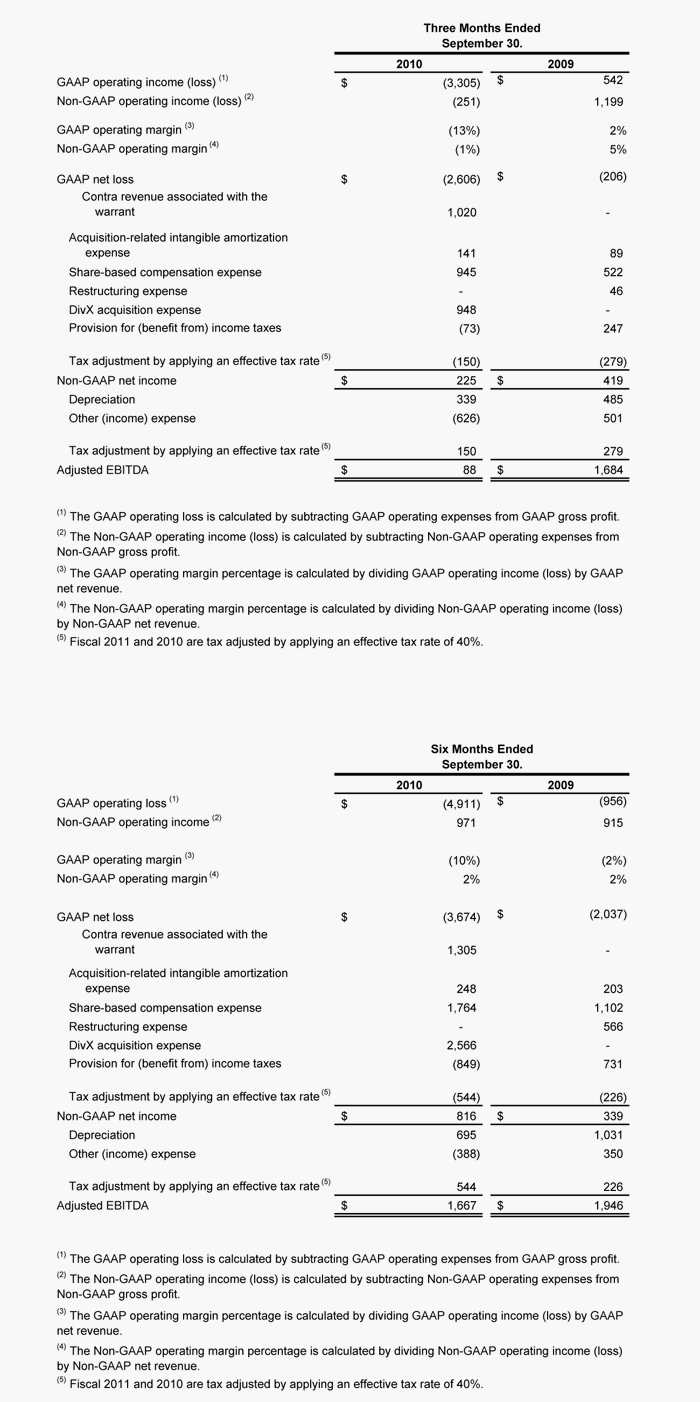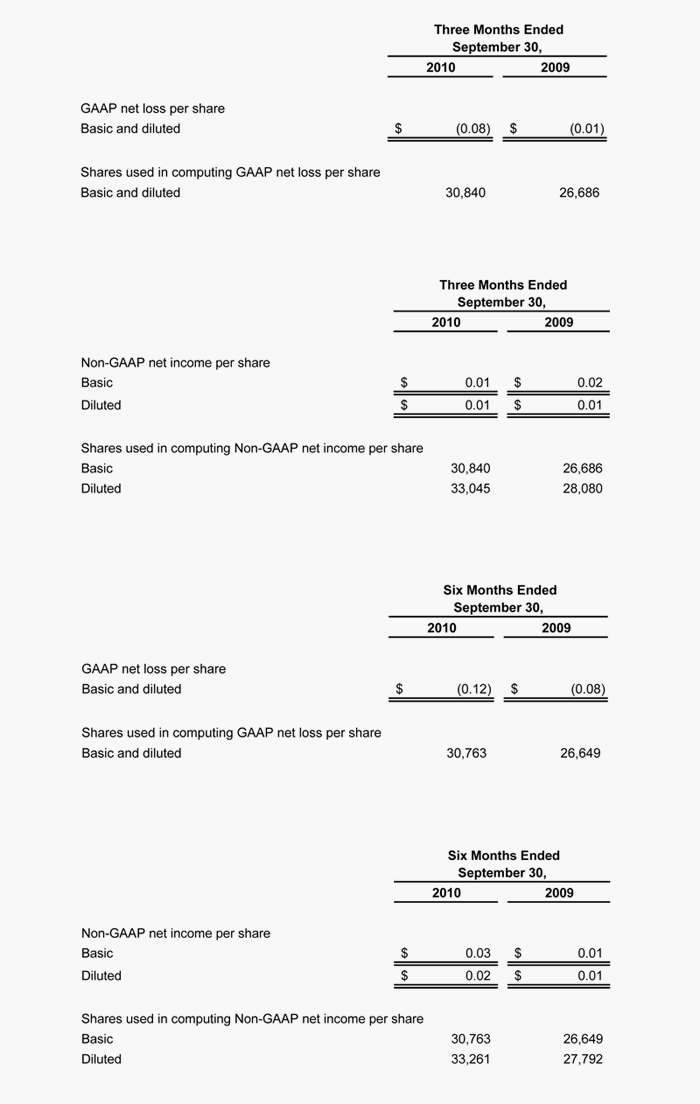![]() Sonic Solutions announced financial results for the second quarter of its fiscal year 2011, ended September 30, 2010.
Sonic Solutions announced financial results for the second quarter of its fiscal year 2011, ended September 30, 2010.
For more information visit: www.sonic.com
Unedited press release follows:
Sonic Reports Second Quarter 2011 Financial Results
Novato, California (November 9, 2010) – Sonic Solutions® (NASDAQ:SNIC) today reported financial results for its second quarter of fiscal year 2011 ended September 30, 2010.
“Our second quarter results were in-line with our expectations and reflect the strength of our value proposition to our customers,” said Dave Habiger, president and CEO of Sonic. “Internet video delivery is transforming the entertainment experience and disrupting traditional physical and broadcast based distribution models. With the combined technology portfolio of Sonic and DivX, we are uniquely positioned to facilitate, and profit from, this shift in entertainment distribution and consumption.”
Second Quarter Fiscal 2011 GAAP Results
In the second quarter of fiscal 2011, Sonic recognized net revenue of $25.3 million, down from $26.1 million reported for the second quarter of fiscal 2010. Sonic’s gross profit for the second quarter of fiscal 2011 was $16.4 million, representing a gross margin of 65%, compared to $18.0 million and a gross margin of 69% in the second quarter of fiscal 2010.
Operating expenses were $19.7 million in the second quarter of fiscal 2011, compared to $17.4 million in the second quarter of fiscal 2010. The GAAP expenses break down as follows: sales and marketing expense was $7.9 million, research and development expense was $6.3 million, general and administration expense was $4.5 million, and expenses associated with acquisitions was $0.9 million.
Net loss for the second quarter of fiscal 2011 was $2.6 million, or $(0.08) per share based on 30.8 million weighted average shares, compared to a net loss of $0.2 million in the second quarter of fiscal 2010, or $(0.01) per share based on 26.7 million weighted average shares.
Second Quarter Fiscal 2011 Non-GAAP Results
Sonic’s non-GAAP net revenue for the second quarter of fiscal 2011 was $26.4 million. The company’s second quarter revenue target was approximately $26.0 million. The effect of $1.0 million of contra revenue associated with the vesting of a warrant issued during the third quarter of fiscal 2010 was excluded from the calculation of non-GAAP net revenue. There was no such contra revenue for the second quarter of fiscal 2010.
Non-GAAP gross profit for the second quarter of fiscal 2011 was $17.6 million, compared to $18.1 million reported for the second quarter of fiscal 2010. In addition Non-GAAP gross profit does not include acquisition-related intangible asset amortization expense of $0.1 million in both the second quarter of fiscal 2010 and 2011.
Non-GAAP operating expenses were $17.8 million in the second quarter of fiscal 2011, compared to $16.9 million in the second quarter of fiscal 2010. These expenses for fiscal 2011 exclude share-based compensation expense of $0.9 million and acquisition expenses of $0.9 million and for the second quarter of fiscal 2010 exclude share-based compensation expense of $0.5 million and restructuring charges of $46 thousand.
Non-GAAP net income for the second quarter of fiscal 2011 was $0.2 million, or $0.01 per diluted share based on 33.0 million weighted average shares. This compares to non-GAAP net income for the second quarter of fiscal 2010 of $0.4 million, or $0.01 per diluted share based on 28.1 million weighted average shares.
Earnings Conference Call
In conjunction with this earnings press release, the Company has posted management’s commentary to the Investor Relations section of its Web site at http://www.sonic.com. Members of Sonic’s management team will host a live conference call today at 4:30 p.m. EST (1:30 p.m. PST), to discuss the financial results. To participate in the conference call, interested parties may dial-in at 888-401-4669 (domestic) or 719-325-2411 (international) and referencing the ID number: 4174163.
To listen to a live audio broadcast of the conference call via the Internet, visit the Investor Relations section of the Sonic Solutions website at http://www.sonic.com. An archived version of the webcast will also be available through this site.
A telephone replay will be available shortly following the call on Tuesday, November 9, 2010 through midnight (PST) on Tuesday, November 16, 2010. The replay can be accessed by dialing (888) 203-1112 (domestic) or (719) 457-0820 (int’l) and entering the passcode: 4174163
Non-GAAP Measures
To supplement our condensed consolidated financial statements, which are prepared and presented in accordance with generally accepted accounting principles (“GAAP”), we report the following non-GAAP financial measures in presenting results and giving guidance: non-GAAP net revenue, non-GAAP cost of revenue, non-GAAP gross profit, non-GAAP gross margin, non-GAAP operating income (loss), non-GAAP operating margin, non-GAAP net income (loss) and non-GAAP net income (loss) per share. We also provide information and guidance regarding our earnings before interest, taxes, depreciation and amortization, excluding restructuring expense, acquisition related expense, share-based compensation and contra revenue (“Adjusted EBITDA”). Our non-GAAP financial measures are not meant to be considered in isolation nor as a substitute for comparable GAAP measures, but should be considered in addition to and in conjunction with results presented in accordance with GAAP. The non-GAAP financial measures are intended to provide additional insight into our operations that, when viewed with our GAAP results and the accompanying reconciliations to the most directly comparable GAAP financial measures, offer a more complete understanding of factors and trends affecting our business. Our non-GAAP presentations should be read in conjunction with our consolidated financial statements prepared in accordance with GAAP.
We believe these non-GAAP financial measures are useful to investors because (1) they allow for greater transparency with respect to key metrics we use in our financial and operational decision-making and (2) they are used by some of our investors and the analyst community to help them analyze our operating results. We use these non-GAAP measures internally to plan and forecast future periods, to establish operational goals, to compare with our business plan and individual operating budgets and to allocate resources. As illustrated by the reconciliation tables below, the effect of calculating these financial measures on a non-GAAP basis is to increase profits, decrease losses and/or change losses to profits. Material limitations associated with the use of the non-GAAP financial measures versus the comparable GAAP measures and guidance are (a) the non-GAAP measures provide a view of our results that does not take into account certain GAAP expenses that would otherwise reduce our profits or increase our losses for the period in question, and (b) it may be difficult or impossible to meaningfully compare our non-GAAP results with those of other companies that do not present non-GAAP results utilizing similar assumptions. We compensate for these limitations by providing full disclosure of the effects of our non-GAAP measures and guidance. Additionally, we present reconciliations between non-GAAP measures and their most directly comparable GAAP measures for non-GAAP historical information and, to the extent available without unreasonable efforts, for non-GAAP forward-looking information, so that investors can use the information to perform their own analysis.
* Contra Revenue. We have excluded the effect of contra revenue associated with our issuance and subsequent vesting of a warrant from our calculation of the following: non-GAAP net revenue, non-GAAP gross profit, non-GAAP gross margin, non-GAAP operating income, non-GAAP operating margin, non-GAAP net income (loss), non-GAAP net income (loss) per share and Adjusted EBITDA. Because of varying available valuation methodologies, subjective assumptions and the fact that the financial impacts of this warrant issuance do not result in ongoing cash expenditures or otherwise have a material impact on our ongoing business operations, we believe that providing non-GAAP financial measures that exclude contra revenue allows investors and analysts to make meaningful comparisons between our ongoing core business operating results and those of other companies. Contra revenue adjustments associated with the grant of this warrant, vesting of the warrant, and changes in the assumptions used to value the warrant will recur during the 2-year vesting period of the warrant.
* Acquisition-Related Intangible Amortization. Under purchase accounting rules, some portion of an acquisition purchase price is generally allocated to intangibles, such as core and developed technology and customer contracts, which are then amortized over various periods of time. Our GAAP presentations include amortization on certain acquired intangibles from prior consummated transactions. We have excluded the effect of amortization of acquired intangibles from our calculation of the following: non-GAAP cost of revenue, non-GAAP gross profit, non-GAAP gross margin, non-GAAP operating income (loss), non-GAAP operating margin, non-GAAP net income (loss), non-GAAP net income (loss) per share and Adjusted EBITDA. Amortization of acquired intangible assets expense is inconsistent in amount and frequency and is significantly affected by the timing and size of our various acquisitions. Further, the amortization expense on acquired intangibles does not result in ongoing cash expenditures, and, in our view, does not otherwise have a material impact on our ongoing business operations. Investors should note that the use of acquired intangible assets contributed to revenues earned during the periods presented and will continue to contribute to future period revenues. This amortization expense will recur in future periods for GAAP purposes.
* Acquisition Related Expense Adjustment. We have excluded the effect of acquisition expense from our calculation of the following: non-GAAP operating expense, non-GAAP operating income (loss), non-GAAP operating margin, non-GAAP net income (loss), non-GAAP net income (loss) per share and Adjusted EBITDA. These expenses are primarily attributable to acquisition expenses associated with the DivX acquisition, beginning in the fourth quarter of fiscal 2010, and consist of the following: (i) professional service fees; and (ii) transition and integration costs. We do not consider these acquisition-related costs to be related to our ongoing operations of the acquired businesses and are generally not relevant to assessing or estimating the long-term performance of the acquired assets. By excluding acquisition-related expenses from our non-GAAP measures, management is better able to evaluate the Company’s ability to utilize its existing assets and estimate the long-term value that acquired assets will generate for the Company. We believe that providing a supplemental non-GAAP measure which excludes these items allows management and investors to consider the ongoing operations of the business both with, and without, such expenses.
* Restructuring Expense Adjustment. We have excluded the effect of restructuring expense from our calculation of the following: non-GAAP operating expense, non-GAAP operating income (loss), non-GAAP operating margin, non-GAAP net income (loss), non-GAAP net income (loss) per share and Adjusted EBITDA. These expenses are primarily associated with the restructuring actions commenced in the fourth quarter of fiscal 2009. As these expenses are directly related to such restructurings, we believe that providing non-GAAP financial measures that exclude these expenses allows investors and analysts to make meaningful comparisons of our ongoing core business operating results over different periods of time.
* Share-Based Compensation Expense Adjustment. We have excluded the effect of share-based compensation expense from our calculation of the following: non-GAAP operating expense, non-GAAP operating income (loss), non-GAAP operating margin, non-GAAP net income (loss), non-GAAP net income (loss) per share and Adjusted EBITDA. Because of varying available valuation methodologies, subjective assumptions and the variety of award types that companies may use, as well as the impact of non-operational factors such as our share price and events such as tender offers on the magnitude of this expense, we believe that providing non-GAAP financial measures that exclude share-based compensation expense allows investors and analysts to make meaningful comparisons between our ongoing core business operating results and those of other companies. Share-based compensation expense will recur in future periods for GAAP purposes.
* Adjusted EBITDA. We provide information and guidance regarding our Adjusted EBITDA. We believe this performance measure is useful to investors because (a) it corresponds closely to the cash operating income (loss) generated from our core operations by excluding significant non-cash operating expenses that do not arise out of our core ongoing operating activities, and (b) it provides greater insight into management decision-making, as Adjusted EBITDA is one of our primary internal metrics for evaluating the performance of our business.
Reconciliation of GAAP to Non-GAAP Measures
As noted above and as reflected in the following reconciliation tables, we have provided reconciliations between the historical non-GAAP measures that we have disclosed and the most directly comparable GAAP measures.
Non-GAAP Net Revenue, Cost of Revenue, Gross Profit & Gross Margin. The following table provides reconciliations relating to net revenue, cost of revenue, gross profit and gross margin (in thousands, except for margin percentages, unaudited):
Operating Expenses. The following table provides reconciliations relating to operating expenses (in thousands, unaudited):
Non-GAAP Operating Income (Loss), Operating Margin, Net Income (Loss) & Adjusted EBITDA. The following table provides reconciliations relating to operating income (loss), operating margin, net income (loss) and Adjusted EBITDA (in thousands, except for margin percentages, unaudited):
GAAP and Non-GAAP Net Income (Loss) Per Share. The following table provides net income (loss) per share (in thousands except per share data, unaudited):
Sonic Solutions® (NASDAQ: SNIC) is a leading developer of technologies, products and services that enable the creation, management, and enjoyment of digital media content across a wide variety of technology platforms. The Company’s products and services offer innovative technologies to consumers, Hollywood and independent studios, original equipment manufacturers (“OEMs”), businesses, high-end professional DVD authoring experts and developers. Sonic distributes its products and services through retailers and distributors, personal computer (“PC”) and consumer electronic (“CE”) OEMs, Internet websites and other channels. The Company’s brands now include Roxio®, RoxioNow™, DivX®, Sonic® and MainConcept®, among others. The Company also licenses core technology and intellectual property to other software companies and technology manufacturers for integration into their own products and services. Sonic software is intended for use with Microsoft Windows and Apple Mac operating systems, as well as some Linux environments and proprietary platforms.
On October 7, 2010, the Company completed the DivX acquisition pursuant to the Agreement and Plan of Merger entered into June 1, 2010. Each share of DivX common stock issued and outstanding immediately prior to the acquisition date was converted into the right to receive 0.514 shares of the Company’s common stock and $3.75 in cash.
Forward-Looking Statements
This press release for the second quarter of fiscal year 2011 contains forward-looking statements within the meaning of Section 27A of the Securities Act of 1933, as amended, and Section 21E of the Securities Exchange Act of 1934, as amended, that are made as of the date of this press release based upon our current expectations. All statements, other than statements of historical fact, regarding our strategy, future operations, financial position, estimated revenue, projected costs, projected savings, prospects, plans, opportunities, and objectives constitute “forward-looking statements.” The words “may,” “will,” “expect,” “intend,” “plan,” “anticipate,” “believe,” “estimate,” “potential” or “continue” and similar types of expressions identify such statements, although not all forward-looking statements contain these identifying words. These forward-looking statements involve known and unknown risks, uncertainties and other factors that may cause the actual results to differ materially from any future results, performance or achievements expressed or implied by such forward-looking statements. Important factors that could cause such differences include, but are not limited to:
* the continuing negative impact of current macroeconomic conditions on consumers and associated impact on their ability and inclination to spend on leisure and entertainment related activities and related software and electronics;
* our ability to generate net income;
* our ability to integrate DivX into our operations;
* our ability to maintain the strength of our brands;
* our ability to adapt to rapid changes in technology and consumer preferences, and to successfully and cost-effectively develop and introduce new and enhanced products and services;
* competitive pressures on our products and services, both from large established competitors with greater technological and financial resources than we possess, and from smaller companies that are able to compete effectively through low-cost Internet sales of their software products and services;
* the impact of declines in our consumer products revenue relating to the DVD format;
* changes in operating results, requirements or business models of our OEM or other major customers;
* our ability to successfully introduce and profitably run our RoxioNow and DivX TV initiatives, businesses with which we have had limited experience, which are dependent on third parties for premium content selection and delivery services, and which may give rise to legal exposure and other business risks;
* expenses and issues associated with qualifying and supporting our products on multiple computer platforms and in developing products and services designed to comply with industry standards;
* issues impacting third parties who supply us with services and operate our web store, as well as retailers, resellers and distributors of our products;
* risks associated with international operations, including risks related to currency fluctuations, as well as our extensive software development operations in China;
* changes in our product and service offerings that could cause us to defer the recognition of revenue, thereby harming our operating results;
* our ability to maintain sufficient liquidity and continue to fund our capital needs;
* the loss of key management personnel;
* risks related to acquisition and integration of acquired business assets, personnel and systems generally;
* costs associated with litigation, patent prosecution, intellectual property and other claims;
* changes in effective tax rates; and
* earthquakes, natural disasters and other unexpected events.
This press release should be read in conjunction with our quarterly report on Form 10-Q expected to be filed on November 9, 2010, and our other reports currently on file with the Securities and Exchange Commission (“SEC”), which contain more detailed discussion of risks and uncertainties that may affect future results. We do not undertake to update any forward-looking statements unless otherwise required by law.





